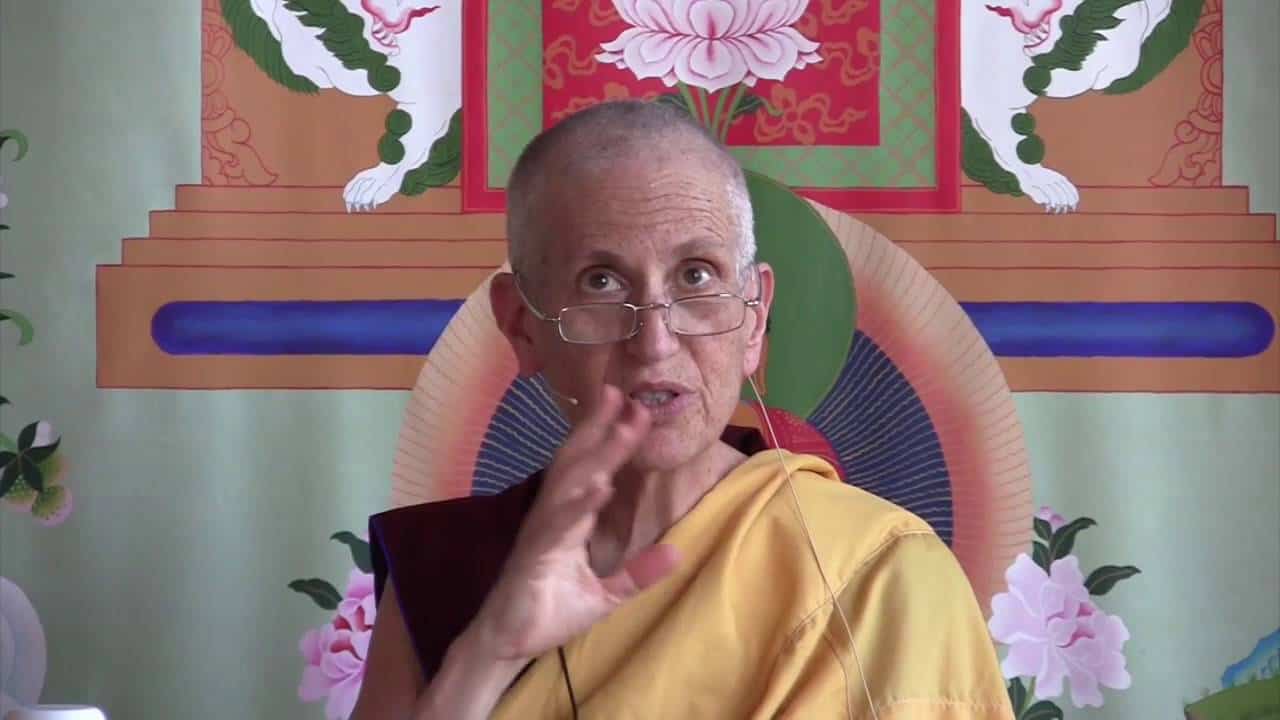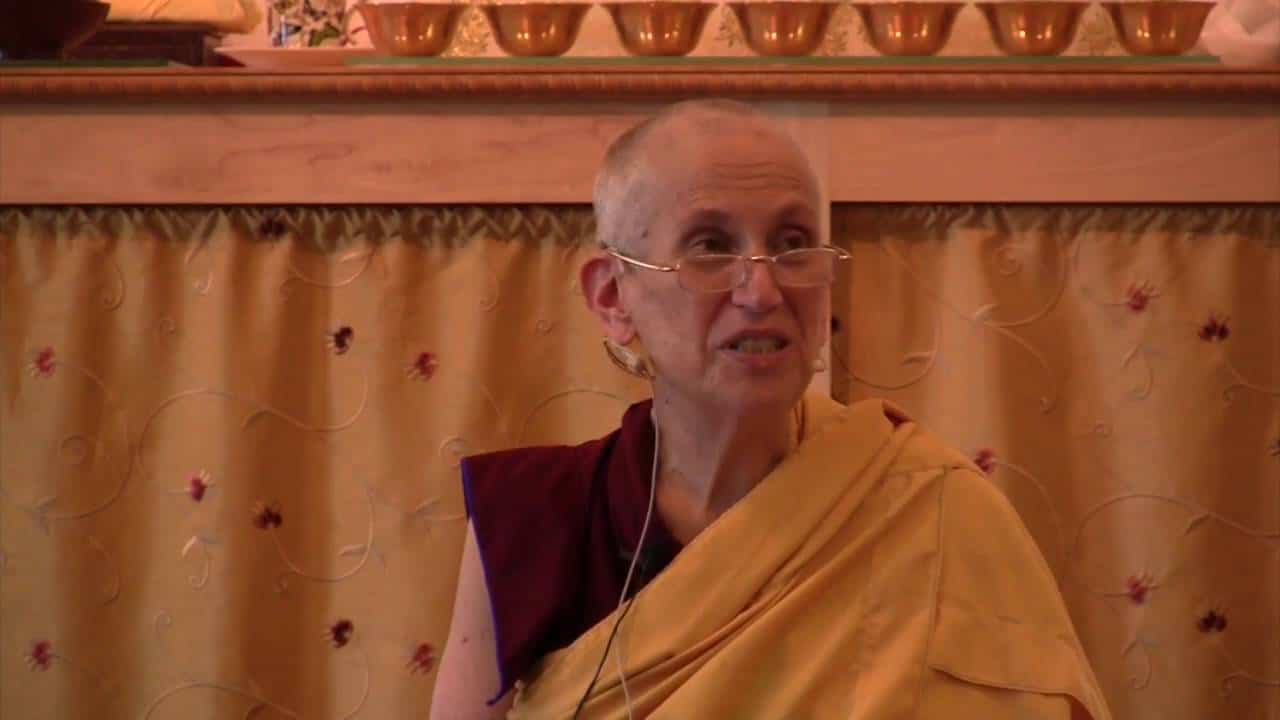Applying the teachings to our minds
Part of a series of teachings on a set of verses from the text Wisdom of the Kadam Masters.
Wisdom of the Kadam Masters: Applying the teachings to our minds (download)
We’ll continue with the text from the Kadampa tradition. We started yesterday on the line,
The best instruction is the constant observation of your mind.
We talked a little bit about that yesterday. I wanted to finish it up today.
Whenever we hear a Dharma teaching then it’s good to use that as a reflection to look at our own mind and see what is going on in our own mind. Let’s say we’re hearing a teaching about karma–I remember this happened when we were doing the Gomchen Lamrim teachings and we went through the four branches that make an action complete karma, and that a complete karma has the power to throw a rebirth, but the incomplete ones don’t. And then people were asking many questions like, “Well what if I intend to steal but then I change my mind?”
That kind of question afterwards shows that the person hasn’t thought about the teaching. Because if you take that teaching, with the four branches, and you take an action that you did yourself (and since there are the ten nonvirtues we go through them one by one). So maybe you take the one of stealing, and you look at an act of stealing you did, and you look, was there the object, was there the three components of the motivation, was there the action, was there the conclusion of the action? And you look at your own action of taking what hasn’t been freely given according to those, and then you can tell if that was a full action or not a full action. And that gives you some understanding of what it means to have complete action versus incomplete. And then you can apply that to all the other situations.
Then if your mind says, “Well what about I intend to steal but then I change my mind?” Well then you’ve already had some experience looking at those, then it’s very clear it’s not an action of stealing. It has part of the motivation, maybe the object, but not the rest of it.
Like that, if you go through everything then it’ll be clearer to you the different things about karma: when it’s complete, when it’s incomplete.
Similarly when we had the teaching about the different factors that make a karma weighty. Again, after you have that teaching, in your meditation you take out an action you did—either a virtuous one or a nonvirtuous one—and you go through and you analyze all those different conditions: what was the strength of the motivation, what was the object that you did it with, what was your basis, what level of precepts did you have, did you purify, was it a repeated action…. You go through all the different criteria, and then you can evaluate your own action, whether it was heavy or light.
Then if you have a question later about, “Oh, is such and such a heavy karma or light one?” You’ve already had some experience in reflecting on that using one of your own actions.
Similarly, before you do purification in the evenings, if you’re having some doubt about something you did during the day, then you think about that, you compare it to the teaching on, let’s say, the ten nonvirtues. Or maybe you did a virtuous action, you want to really understand it well, you compare it to that. Then you go through the different factors that make it heavy or light. Then in that way you’re really applying the teaching to your own mind, and you’re understanding your own karma, and that gives you impetus to purify what you need to purify, to rejoice and dedicate the virtue you’ve done. Then that helps also when you have questions about how karma works.
When it says the “best observation is to look at your own mind,” it means whatever teaching you hear, then you apply that to your mind and you understand that teaching by applying it to your own experience.
Or if you hear, let’s say, a teaching, you may say, “Well what about a teaching on the qualities of the Buddha? How in the world do I apply that to my mind, because those are the qualities of the Buddha and my mind certainly isn’t a buddha.”
Well, one way is to think about the different qualities of the Buddha’s body, speech, and mind, and imagine what it would be like to have those qualities yourself. Then that gives you some idea, “What’s the difference between my speech and the Buddha’s speech?” There’s quite a big difference here. What’s the difference? Then you go into contemplating what’s the difference between how I speak, how the Buddha speaks. And then, “What do I need to do to practice, and what do I need to abandon, in order to transform my speech into the speech like the Buddha’s speech?
Then you imagine what it would be like having the Buddha’s speech. That would be pretty nice, wouldn’t it? First of all you wouldn’t need these things (the sound system). But aside from that, aside from the selfish pleasure of not needing to be hooked up (to the sound system), you can think that your speech then would become…. Whoever hears it would gain some benefit from it. And your speech would have some power, because of the realizations that lay behind it. And then you would be able to say the right thing at the right time to really benefit somebody.
You think like this about what it would be like, and so that helps you, first of all, to gain deeper confidence in the Buddha because you understand the Buddha’s qualities on a deeper level. And second of all, you see the kind of qualities that you can start developing now in order to slowly train your speech to be like the Buddha’s speech.
In all the teachings we hear then we should apply them to our mind in this kind of way, apply them to our lives. Then they become very meaningful, and it also gives us the ability to think about other people’s questions, or think about our own questions, instead of kind of, you hear a teaching, you take notes, put it away. Or if you review your notes, you’re reviewing it like this is some outside topic out there, and all I have to do is memorize the points. If you do it like that then you don’t get that same experience, it’s just intellectual memorizing the points. But if you really apply it to your life and analyze what you’ve experienced through this, then it really brings much more of a feeling into your heart, and a deeper understanding.
So, that’s another meaning here when it says, “The constant observation of your mind.” Yesterday we talked about it as being observation of what our body, speech, and mind are doing and seeing if they accord with our precepts, if our actions are according with our values and principles, and so on. What I explained today is a different way of understanding that, but also valuable.
So, you should have some things to meditate on. [laughter]
Venerable Thubten Chodron
Venerable Chodron emphasizes the practical application of Buddha’s teachings in our daily lives and is especially skilled at explaining them in ways easily understood and practiced by Westerners. She is well known for her warm, humorous, and lucid teachings. She was ordained as a Buddhist nun in 1977 by Kyabje Ling Rinpoche in Dharamsala, India, and in 1986 she received bhikshuni (full) ordination in Taiwan. Read her full bio.


